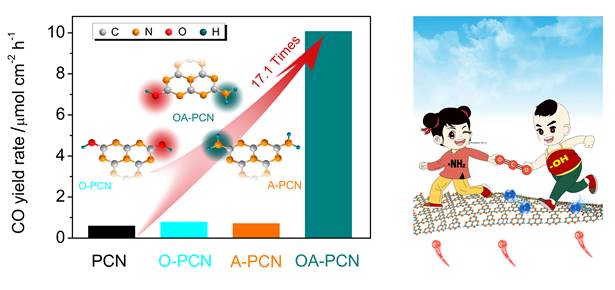| Superficial Hydroxyl and Amino Groups Synergistically Active Polymeric Carbon Nitride for CO2 Electro-reduction |
| From: PublishDate:2020-07-29 Hits: |
The greenhouse effect leads to a deteriorating global climate. CO2 electro-conversion (CO2-EC) offers an intriguing approach to mitigate climate change and simultaneously transform CO2 into value-added chemicals, which can eventually achieve the artificial carbon cycle. The development of advanced catalysts is the core challenge in this field. Currently, metal-containing materials have been widely explored as the electro-catalysts for CO2-EC, but their high cost, potential toxicity, and limited resources hamper their practical applications. Recently, metal-free materials, such as graphene, mesoporous carbon, nanodiamond, carbon nanotubes, and carbon nanofibers, can be activated for CO2-EC by the element doping of nitrogen, boron, sulfur, or fluorine. At present, all the reported metal-free CO2-EC catalysts are mostly focused on doped carbon materials and hetero-atoms serving as active sites for CO2-EC. Are there any other metal-free materials and novel active sites that possess high activity for CO2-EC? Carbon nitride (PCN), composed of the tri-s-trazine rings, is a conjugated polymer. It possesses many intriguing properties, including robust chemical stability, biological compatibility, tunable structure, affordable production, low cost, and environmental benignity. Since the binding capacity between the PCN framework and the proton is strong in favor of the proceeding of hydrogen evolution reaction, thus resulting in the inert feature of PCN for CO2-EC. Bin Zhang group at Tianjin University reported a simple dual functionalization strategy to activate PCN from the inter material to the active catalyst for CO2-EC. A series of experimental results demonstrate that superficial hydroxyl and amino groups can serve as dual active sites to activate PCN for CO2-EC. Theoretical simulation proves superficial hydroxyl and amino groups can synergistically decrease activation energy for CO2-EC, optimize the reaction pathway, and thus improve the catalytic performance. The relevant research has been published in the journal “ACS Catalysis” on Oct, 30, 2019.
To overcome the shortage of the traditional characterization technique that cannot obtain the fine amorphous local structure, 1W1B-XAFS station of Beijing Synchrotron Radiation Facility (BSRF) is employed and discover that the frameworks of superficial hydroxyl modified PCN (O-PCN), superficial amino groups modified PCN (A-PCN) and superficial hydroxyl and amino groups co-modified PCN (OA-PCN) maintain well with that of PCN. By combining the similar activity of O-PCN, A-PCN, and PCN with the results of BSRF, we can initially deduce that the active origin of OA-PCN might be relative with its superficial functional groups. Further ruling out the contributions of the surface area, electrochemically active surface area, hydrophilicity, CO2 adsorption ability, and electro-conductibility to the catalytic performance, we can conclude that superficial dual groups devote to the high activity of OA-PCN. These results are also consistent with the theory prediction. Thus, the synergistically catalytic mechanism of superficial dual groups can be demonstrated. The precise structure determination of carbon nitride can help us to judge where changes have been occurred in the structure, thus resulting in performance enhancement. It can also benefit to analyse the electro-withdrawing/-denoting effect when the introduction of superficial dual groups, which is also important for understanding the catalytic mechanism. “This is an interesting discovery. A simple dual functionalization strategy can transform the material activity from inter to active, even approaching the efficiency of metal-based catalysts. This is an emerging catalytic system.” explains Bin Zhang, the team leader and the professor of the School of Science, Tianjin University. “It also shows that BSRF possesses the unique advantage for characterizing the amorphous structure and unravelling the active species for understanding the reaction mechanism.” Article: Nannan Meng, Wei Zhou, Yifu Yu, Yang Liu, and Bin Zhang*. Superficial Hydroxyl and Amino Groups Synergistically Active Polymeric Carbon Nitride for CO2 Electro-reduction. ACS Catal., 2019, 9, 12, 10983-10989. |
|
|
| Chinese
- Metal-free efficient photocatalyst for stable visible water splitting——Top ten major scientific progresses in China in 2015
- The nano-resolution imaging platform was awarded the first rate prize of Beijing Science and Technology in 2014
- Beamline 1W1 of BSRF started to runoperate in the couplingparasitic mode of BEPCII
- Synthesis of High Performance Polymer Materials for Field Effect-Transistors
- Surfactant molecular aggregates in green solvents
- GIXRD has played an important role in the characterization of organic thin-film transistors
Science Highlights
Home /
Copyright © 2011 - 2012 Beijing Synchrotron Radiation Facility


